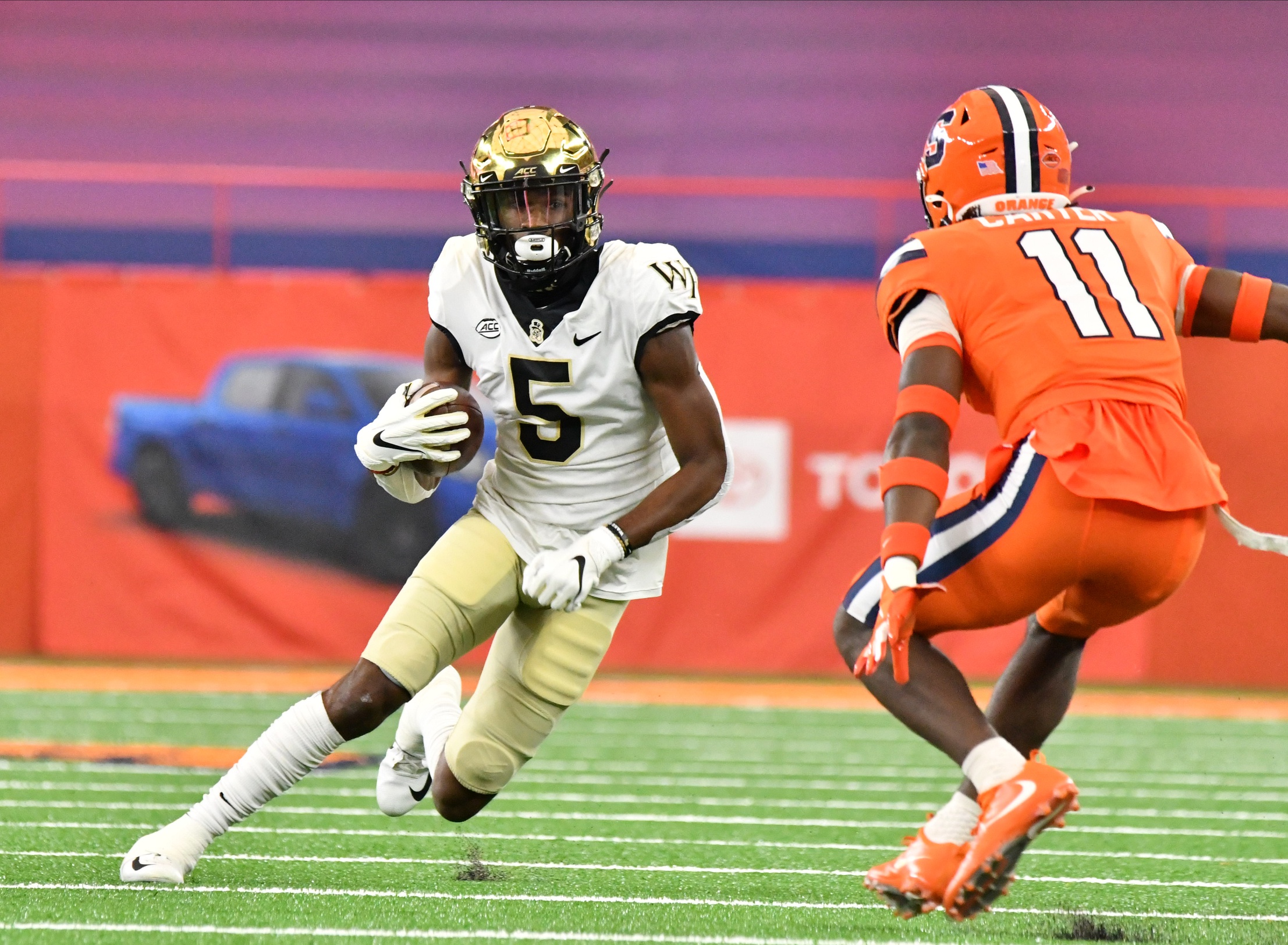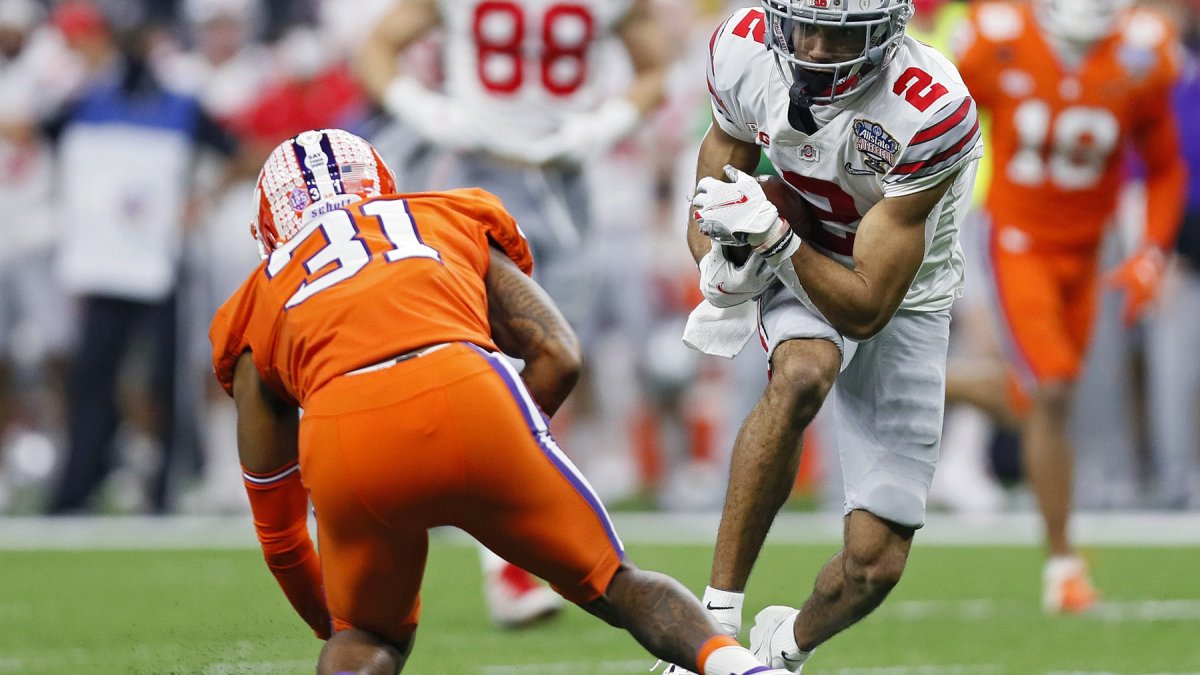The 2021 college football season kicks off in just over 100 days, and we at PFF are here to get you ready for it. We'll start by ranking the top 10 returning players at each position and naming one sleeper who could make some noise this season.
Below is a list of PFF’s top 10 returning wide receivers. The list is based on a bevy of factors, including PFF grade and other advanced metrics available to CFB Premium Stats+ subscribers. And remember, this has nothing to do with pro potential.
(NOTE: Georgia WR George Pickens was initially ranked fourth on this list but was removed due to a torn ACL suffered in late March that will keep him out of the entire 2021 regular season .)
Subscribe to
Find the rest of PFF’s top returning college players series here:
QB | RB | WR | TE | OT | iOL | DI | EDGE | LB | CB | S
1. CHRIS OLAVE, OHIO STATE
Olave was projected to be a first-round selection in the 2021 NFL Draft but made the surprising decision to return to school and boost his stock even higher. For the Buckeyes, this is clearly fantastic news. They are returning perhaps the most refined route-runner in college football.
Great route from Chris Olave and ball placement from Justin Fields. Have seen this route called a Stool route (Wheel+Sit) and this was perfect execution. pic.twitter.com/CNnNxM8iGq
— Nate Tice (@Nate_Tice) January 2, 2021
Olave has generated a step or more of separation on over 87% of his targets since 2019, the highest rate in the country. Against single coverage over the past two seasons, he has racked up 15 receptions of 15-plus yards in which he had more than a couple of steps of separation. That trailed only Alabama's DeVonta Smith for the most in the FBS (19) and was five more than the next-best Power Five receiver.
2. GARRETT WILSON, OHIO STATE
Ohio State may no longer have Justin Fields, but the team certainly has the clear-cut best wide receiver duo in the country. That’ll surely ease the transition for (most likely) C.J. Stroud at quarterback.
Like his teammate Olave, Wilson is one of the best route-runners in the game. He impressed against single coverage (sixth in PFF grade on such plays) and frequently found soft spots against zone while working from the slot. That led to a separation rate that ranked eighth-best in college football this past season. The 2019 five-star recruit is bound to put up numbers in this offense once again in 2021.
3. JUSTYN ROSS, CLEMSON
Ross missed the 2020 season due to a spinal condition that led to a fusion surgery this past offseason put his career in jeopardy. Fortunately, it looks like he will be cleared moving forward, and that means Clemson returns a top-three receiver in the game.
NOTRE DAME: TACKLE HIM!
Justyn Ross: nah, I'm good pic.twitter.com/cLiPoIRvSP
— CBS Sports (@CBSSports) December 29, 2018
The 6-foot-4 receiver earns his cheddar on vertical routes. He established himself as one of the best deep threats in college football in his two seasons prior to 2020, coming away with the third-most touchdowns on targets of 20-plus yards during that span (11). His size comes in clutch on these targets, as he flat-out bodies defensive backs in contested situations — he's hauled in nine of 13 such deep targets in his career. Ross isn’t uber-athletic, but he wins so often because of his physicality.
4. TREYLON BURKS, ARKANSAS
Burks took his play to new heights in 2020 after being solely utilized as a deep threat in 2019 as a true freshman. He improved his receiving grade from 70.5 to 88.9 this past season. Burks still made his fair share of deep plays, but he started to produce on the underneath and intermediate route trees, too.
With his size, physicality and speed, Burks was a hard man to tackle, averaging 7.6 yards after the catch and breaking nine tackles on 50 receptions in 2020. Those traits have helped him vertically, as well. Over the past two seasons, he has been responsible for 17 receptions of 20-plus yards, the 10th-most among Power Five receivers. And he did that as an underclassman.
5. MARVIN MIMS, OKLAHOMA
Mims wasn’t the first, second or even third option in the Oklahoma offense this past year. The true freshman ranked fourth on his team in total routes run but was by far the most productive Sooner and one of the most productive receivers in the FBS. His 89.1 receiving grade and 4.07 yards per route run both ranked among the 10 best marks at the position in 2020.
The 5-foot-11 and 177-pound receiver showed quality body adjustment and speed while routinely getting open downfield. Despite seeing only 49 targets, Mims was able to bring down 11 deep receptions in 2020 (tied for the fourth-most in the Power Five). His stock is on the rise for 2021.

6. JAQUARII ROBERSON, WAKE FOREST
Roberson came into the season with 29 targets in three years at Wake Forest and has finished 2020 as the second-highest-graded wide receiver in the FBS (92.6) — just like we all expected. He exploited holes in zone coverage like clockwork for the Demon Deacons and extended several plays in the open field with his after-the-catch ability.
Roberson’s 340 receiving yards against zone were the second-most in the Power Five, and he racked up 7.6 yards after the catch and eight broken tackles on 16 such receptions. He also won with his routes in one-on-one opportunities; his separation percentage against single coverage was the ninth-best in the FBS in 2020.
7. KHALIL SHAKIR, BOISE STATE
Shakir went from playing predominantly in the slot in 2019 to mostly out wide in 2020, but his production didn’t skip a beat. His strong 88.2 receiving grade from 2019 increased slightly to 88.8 this past season, the ninth-best mark in the FBS. Regardless of alignment, though, Shakir was uber-productive. He joined Alabama's DeVonta Smith and Ole Miss' Elijah Moore as the only FBS wide receivers to generate over 3.2 yards per route run in both the slot and out wide.
8. DAVID BELL, PURDUE
Bell is far from a separator, but he makes up for it with top-notch body control and strong play against tight coverage. As a true freshman and sophomore over the past two years, the 6-foot-2, 205-pound receiver produced a receiving grade against tight coverage that trails only LSU's Ja’Marr Chase and Alabama's DeVonta Smith in the Power Five. His 30 contested catches over those two years are also seven more than anyone in the Power Five.
For most receivers, falling down along a route like Bell did on this play would have resulted in an incomplete ball. But not for the Purdue receiver.
This catch by @BoilerFootball‘s David Bell is simply amazing. Flat out lays out.
Indiana 21, Purdue 10 in this battle for that Bucket. pic.twitter.com/fNroa3L5DK
— Big Ten Network (@BigTenNetwork) November 30, 2019
9. TY FRYFOGLE, INDIANA
Fryfogle had a mini breakout this past season when quarterback Michael Penix Jr. was on the field. In the five games prior to his quarterback going down with a season-ending injury, Fryfogle ranked ninth in the FBS in receiving grade (87.2). Like Bell from Purdue, Fryfogle isn’t going to win with separation. He beats opponents with his 6-foot-2, 214-pound frame and physicality at the catch point, line of scrimmage and along the route.
For the season, no Power Five receiver generated a higher PFF grade on contested targets than Fryfogle. He was responsible for nine contested receptions of 15-plus yards in 2020, two more than any other Power Five receiver. His route tree is extremely limited, but he is a true go/back-shoulder weapon.
10. JOHN METCHIE III, ALABAMA
DeVonta Smith was of course the most productive wide receiver against press coverage in the 2020 season, but right behind him was teammate John Metchie III, who will now be the focal point of the Alabama offense. The sophomore put up 3.55 yards per route run against press coverage in 2020, which was the fifth-most we have seen among Power Five wide receivers in the last five years.
Metchie has that second gear to get on top of defensive backs and handles contact well along the route, but the latter disappears at the catch point in contested scenarios (he caught four of 13 in 2020), and he isn’t much of a tackle breaker after the catch. I’m expecting some growth and a big junior year breakout from Metchie, but at a minimum he’s going to be a big-play threat for the Crimson Tide.
ONE MORE NAME TO WATCH: JALEN TOLBERT, SOUTH ALABAMA
Tolbert first popped up on our radar after closing out his 2019 campaign with an unreal five-reception, four-touchdown, 144-yard and 90.2 PFF-graded performance. The junior managed to show that it was no fluke in 2020. The 6-foot-3, 195-pounder made plays deep downfield week-after-week for the Jaguars with the help of his body control and massive catch radius.
Jalen Tolbert: 6 catches, 169 yards, 2 TDs
23-13 South Alabama late 3rd Q pic.twitter.com/u0ydUvc3VW
— Barstool Sun Belt (@barstoolsunbelt) September 4, 2020
Tolbert finished the year with a 79.2 PFF grade (13th among returning wideouts) and 15 receptions 20-plus yards downfield, tied with Jonathan Adams Jr. and DeVonta Smith for the most in the FBS. Tolbert also drew a DPI on five other deep targets, tying for the second-most in the FBS. He saw 15 targets over 10 yards downfield in 2020 that we charted as catchable but inaccurate, yet he hauled in 12 of those — quite frankly an absurd rate. Those 12 catches on such plays are tied for the 14th-most in a single-season over the last three years among FBS wide receivers.
Expect Tolbert to challenge Khalil Shakir for top Group of 5 wide receiver in 2021.



 © 2025 PFF - all rights reserved.
© 2025 PFF - all rights reserved.